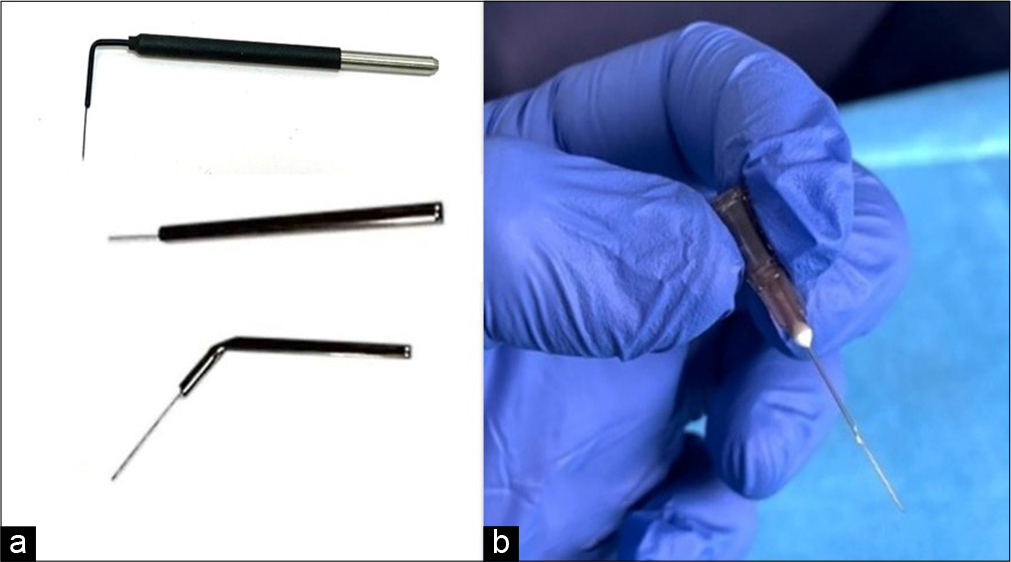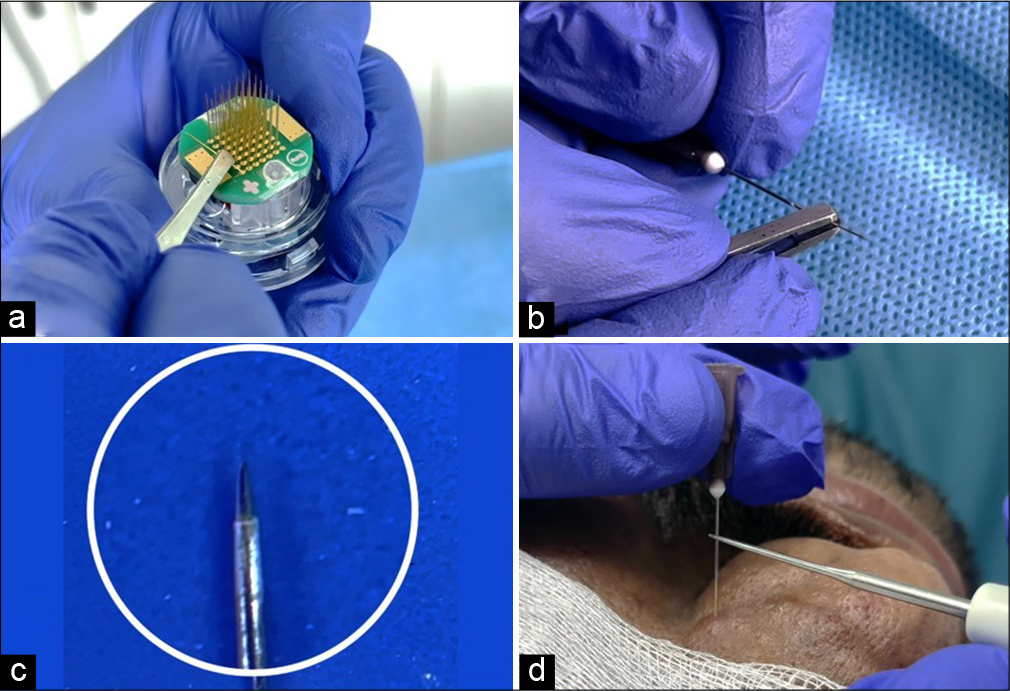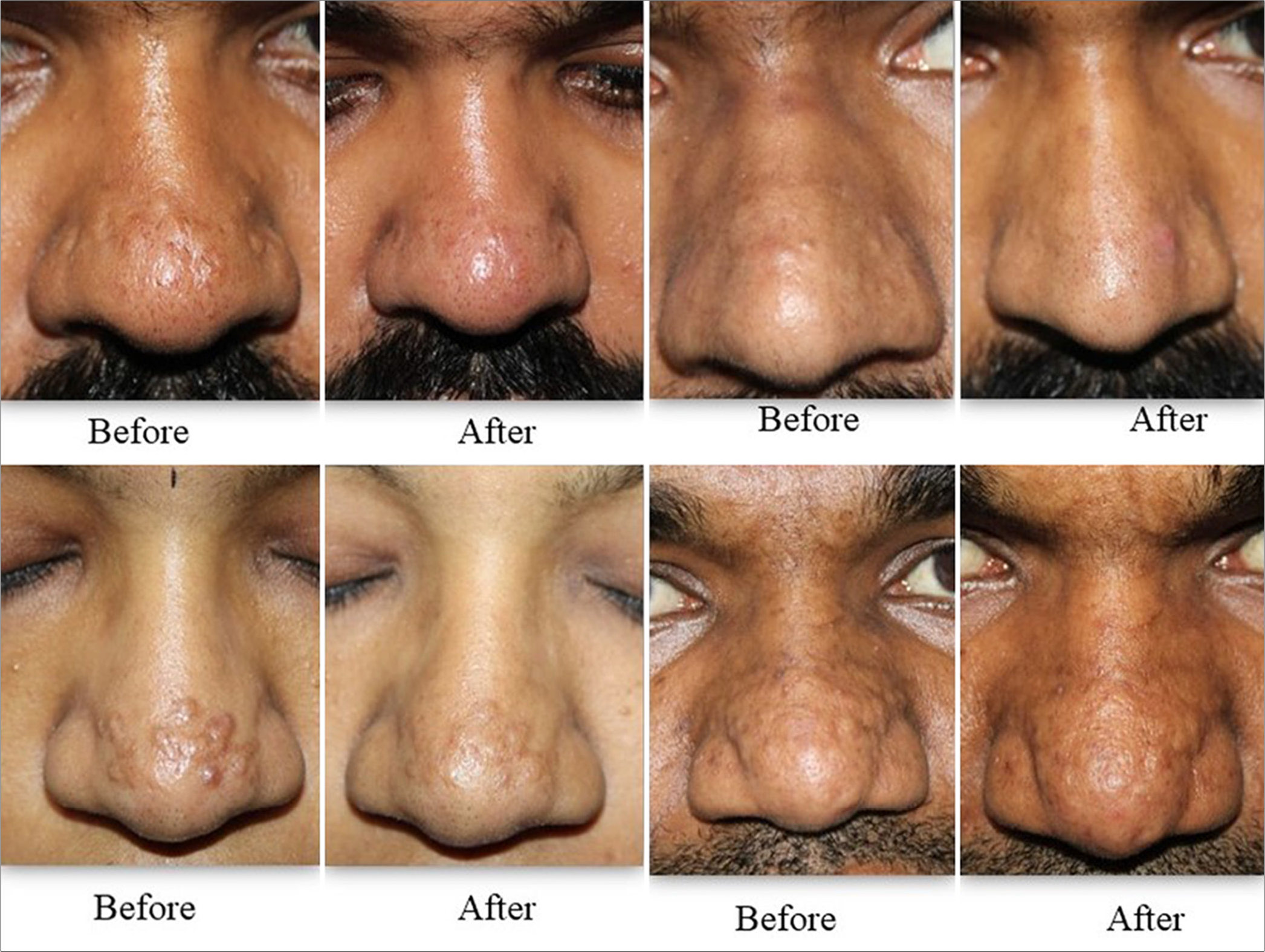Translate this page into:
Innovative cost-effective insulated needle probe for intralesional radiofrequency
*Corresponding author: B. S. Chandrashekar, Department of Dermatology, CUTIS Academy of Cutaneous Sciences, Bengaluru, Karnataka, India. cutisclinic@gmail.com
-
Received: ,
Accepted: ,
How to cite this article: Nehete SS, Chandrashekar BS. Innovative cost-effective insulated needle probe for intralesional radiofrequency. J Cutan Aesthet Surg. doi: 10.25259/JCAS_10_2025
Abstract
Intralesional radiofrequency (ILRF) is a treatment that delivers energy directly into lesions while sparing the outer skin layer. This reduces the chances of post-inflammatory marks and scarring. ILRF when used for smaller size lesions such as papular scars, syringoma, and electrolysis epilation probes are available conventionally where a stainless steel electrode is coated with polytetrafluoroethylene (Teflon). There are multiple problems faced with such probes such as frequent breakage, bending, and adverse events like post-inflammatory hyperpigmentation. An innovative and cost-effective insulated needle probe has been developed using a needle from a microneedle radiofrequency probe. This advanced design minimizes the adverse effects commonly associated with conventional probes while enhancing efficacy using superior-quality materials.
Keywords
Dermatological conditions
Disposable tips
Intralesional radiofrequency
Microneedle radiofrequency
INTRODUCTION
Intralesional radiofrequency (ILRF) is a treatment modality that delivers energy directly into lesions while sparing the outer skin layer.1 This targeted approach reduces the risk of post-inflammatory marks and scarring, making it an effective option for managing challenging conditions like papular scars – difficult-to-treat acne scars that often require multiple sessions. In addition, ILRF has proven to be effective in treating conditions such as keloids, hypertrophic scars, syringoma, hidrocystoma, and electrolysis procedures.1 Here, we will be restricting the discussion to the lesions that can be treated with finer, smaller needles.
For smaller lesions, insulated needle probes are commonly used. These probes are thin and made of stainless-steel needles coated with polytetrafluoroethylene or Teflon [Figure 1a]. Despite their utility, conventional probes present certain limitations. These include a tendency to bend or break, resulting in high recurring costs. The insulation quality of Teflon is inferior compared to silicon, reducing durability and performance. In addition, issues such as tip charring and coagulated tissue sticking to the needle often occur due to the conductivity of the metal used. The higher the conductivity, the lower the chances for charring of the tip. These challenges complicate reinsertion into the lesion, increase the risk of post-inflammatory hyperpigmentation and scarring, and necessitate careful handling. Moreover, the cost of such probes ranges from 750 to 1500 INR/unit, further adding to the expense.

- (a) Conventionally available insulated needle probes (b) Innovation - insulated needle probe for intralesional radiofrequency
THE INNOVATION: A COST-EFFECTIVE SOLUTION
To address the limitations of traditional probes, a novel and cost-effective method was developed using disposable tips from microneedle radiofrequency (MNRF) probes. MNRF technology involves the delivery of radiofrequency energy to tissue through multiple insulated or non-insulated needles arranged in a grid.2 By leveraging MNRF disposable tips, a single needle is dismantled and mounted inside the lumen of a 26 G needle [Figure 1b]. Commercially available cyanoacrylate glue is then introduced inside the 26 G needle from the proximal end. The internal lumen of the 26 G needle is such that the MNRF needle just snuggly fits into it. The stability of the assembly primarily relies on the arrangement itself, with the glue serving as a secondary component to enhance the stability. During the procedure, the electrode is touched to the proximal part of the 26 G needle, enabling precise energy deposition into the lesion while sparing the epidermis [Figure 2]. Number of sessions required was dependent on the severity of the papular scars. Around 3–4 sessions, once in 3 weeks, provided adequate outcomes [Figure 3]. No complications were noted. However, counseling of patients regarding temporary post-inflammatory hyperpigmentation was done.

- Procedure to make the insulated needle probe. (a) Microneedle radiofrequency (MNRF) tip is dismantled, and one needle is taken from the base. (b) It is mounted inside the lumen of the 26 G needle. (c) Microscopic view of MNRF needle showing insulation of the needle except the tip part. (d) Procedure of intralesional radiofrequency using this probe for popular scars.

- Before and after photographs demonstrating the clinical efficacy of intralesional radiofrequency using this probe on papular scars.
ADVANTAGES OF THE NEW PROBE
The innovative probe offers significant advantages over traditional methods: Enhanced Durability and Insulation: The double-coated silicone insulation ensures superior durability compared to Teflon, providing better performance and reliability during treatments.
Improved Conductivity and Reduced Tip Charring: Gold-coated stainless-steel needles optimize conductivity, minimizing tip charring and ensuring efficient energy delivery to the target lesion. With reduced charring of the tip, re-insertion into the other lesion becomes easier.
Cost-Effectiveness: Traditional epilation probes cost around 1500 INR each. In contrast, MNRF disposable tips containing 49 needles cost around 4500 INR, reducing the cost per needle to only 92 INR. This represents a 93% reduction in cost per needle, making the innovation highly affordable.
Ease of Replacement: With low cost and easy procedure to make a probe, it can easily be replaced more often. It ensures that the probes have sharper tips, which can give more precise treatment outcomes.
Fewer Side Effects: The higher quality of the probe minimizes tissue damage, post-inflammatory hyperpigmentation, and scarring, contributing to safer and more effective treatment.
Versatility in Use: This innovation is particularly useful for treating smaller lesions in conditions such as papular scars, syringoma, hidrocystoma, and electrolysis.
LEARNING POINTS
ILRF offers a precise and effective method for treating challenging dermatological conditions such as papular scars and syringoma while minimizing the risk of post-inflammatory hyperpigmentation and scarring.
Traditional insulated probes have limitations such as high cost, reduced durability, and complications like tip charring, necessitating a more effective alternative.
A novel probe using disposable tips from MNRF addresses these limitations with superior durability, optimized energy delivery, and significantly reduced costs.
The innovative design allows for cost savings of up to 93% per needle compared to traditional probes, making advanced dermatological treatments more accessible and affordable.
The enhanced quality and reduced side effects of the new probe ensure safer, more effective, and reliable treatment outcomes.
CONCLUSION
The introduction of a cost-effective, innovative probe using MNRF disposable tips revolutionizes ILRF treatments. By overcoming the limitations of conventional insulated probes, this method offers improved durability, reduced costs, and enhanced safety and efficacy. Its wide applicability in dermatological conditions and its affordability make it a valuable advancement in the field of dermatologic surgery and esthetic practice.
Authors’ contributions
Sanket Sanjay Nehete: Concept, making the manuscript, collection of data, analysis of data, writing manuscript, editing manuscript, B. S. Chandrashekar: Concept, review of manuscript.
Ethical approval
Institutional Review Board approval is not required.
Declaration of patient consent
The authors certify that they have obtained all appropriate patient consent.
Conflicts of interest
There are no conflicts of interest.
Use of artificial intelligence (AI)-assisted technology for manuscript preparation
The authors confirm that there was no use of artificial intelligence (AI)-assisted technology for assisting in the writing or editing of the manuscript and no images were manipulated using AI.
Financial support and sponsorship: Nil.
References
- Intralesional radiofrequency for papular acne scars. Indian Dermatol Online J. 2019;10:486-7.
- [CrossRef] [PubMed] [Google Scholar]
- The clinical efficacy and safety of microneedling fractional radiofrequency in the treatment of facial wrinkles: A multicenter study with the Infini System in 499 patients White paper Goyang, South Korea: Lutronic Corp; 2013.
- [Google Scholar]







